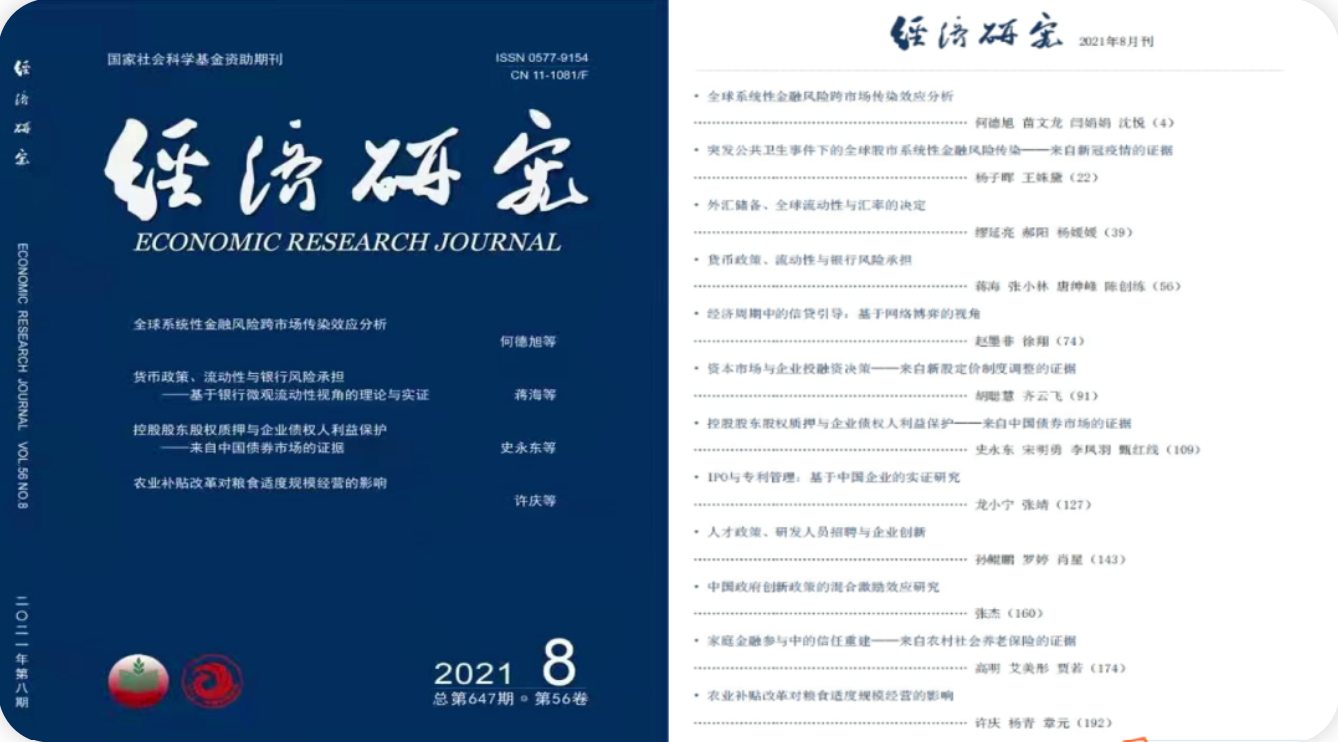岭南观点·25 突发公共卫生事件下的全球股市系统性金融风险传染——来自新冠疫情的证据
杨子晖教授、王姝黛博士后
我院杨子晖教授与王姝黛博士后合作的论文《突发公共卫生事件下的全球股市系统性金融风险传染——来自新冠疫情的证据》于2021年8月在经济学中文顶级期刊《经济研究》发表。

有鉴于此,本文采用最新发展的弹性网络收缩技术,对50个国家(地区)的股票市场展开分析。基于高维收益溢出与波动溢出网络,本文研究了新冠疫情背景下,国际股票市场的风险传染关系。在此基础上,我们采用网络拓扑分析方法,考察不同类型市场的风险特征,并深入剖析金融风险传导的驱动因素。最后,我们从突发公共危机治理的新视角,为有效应对疫情冲击、防范输入性风险传染提出了相关建议。
本文的实证研究主要有以下发现:(1)受突发公共事件的冲击影响,全球股市风险网络存在显著的地理溢出效应。由于新冠疫情的蔓延与人口、货物流动密切相关,疫情爆发存在地理集聚现象,因而其引发的金融动荡也呈现出地理集聚效应。(2)疫情较为严重的地区、资本较为开放地区、经济较为发达的地区是主要的系统性金融风险动荡源。(3)国际贸易、资本开放均可能成为金融风险传染背后的驱动因素。在贸易依存度与资本开放度较高的经济体之间,风险传染效应更为明显。(4)单一市场对国际市场的风险冲击与其疫情严重程度显著正相关,而海外疫情风险的持续上升将加剧本土金融市场的脆弱性。(5)随着新冠肺炎疫情的蔓延,全球股市风险溢出效应持续攀升,并于2020年3月达到峰值,同期我国面临的输入性风险冲击也不断走高。(6)新冠肺炎疫情的爆发主要通过以下两种渠道影响全球股市风险扩散的路径:第一,突发公共卫生事件爆发初期,疫情冲击将直接导致本国资本市场的投资恐慌与避险情绪高涨,进而加剧系统性金融风险。第二,随着疫情扩散,经济停摆引发的国际价值链断裂,将从基本面角度对全球股市风险传导产生间接影响。
基于上述研究发现,本文指出,尽管现阶段我国资本市场呈稳定发展态势和较强韧性,但我们需对此保持审慎乐观,全球疫情风险仍在反弹,我国还将持续面临不确定性的冲击。目前,新兴市场已逐渐成为全球新冠肺炎疫情的震中。我国应密切监测以上地区金融市场的动态,建立成熟的尾部事件应对机制。此外,在海外市场发生异常波动的时期,我国应及时采取措施稳定国内市场预期,高度警惕亚洲市场间的风险传染。
Summary
In 2020,as the COVID-19 pandemic sweeping across the world,the global stock market experienced an unparalleled slump,and systemic risk spread rapidly across international markets. Controlling imported financial risk has become a common challenge for governments all around the world. Therefore,identifying the source of stock fluctuation and revealing the path of risk transmission under the COVID-19 crisis can be very valuable. It helps to find the origin of risk in international markets and prevent imported financial risks. Besides,it also helps to examine the factors that contribute to cross-market contagion of risks,so as to provide suggestions on improving risk monitoring mechanism and risk governance under public emergencies.
In this paper,we apply the latest elastic net shrinkage ( Gross & Siklos,2020) to analyze the stock markets in 50 countries ( regions) . Based on the high-dimensional return spillover and volatility spillover networks,this paper studies the risk contagion of international markets under the COVID-19 pandemic. Then,we adopt topological analysis to investigate the risk characteristics of different types of economies,and clarify the driving factors of financial risk transmission. Lastly, from a new perspective of public crisis governance,we put forward policy implications for responding to the COVID-19 crisis and preventing imported financial risks.
The main findings of this paper are as follows. (1) Our results identify a geographic spillover effect in global stock markets. Since the spread of the COVID-19 pandemic is closely related with the flows of population and goods,the outbreak of the pandemic may be geographically agglomerated. Thus,the financial turmoils caused by it also show geographic effects. (2) Under public health emergency,regions with severe pandemic,high capital openness,and developed economies are main sources of systemic risks. (3) International trade and capital opening may be the driving factors of financial-risk contagion. Between economies with high degree of trade dependence and capital openness,the risk contagion effect is more obvious. (4) The risk impact of a country ( region) on the international market is significantly positively correlated with its severity of pandemic. And the increase of overseas pandemic risk will exacerbate the vulnerability of domestic financial market. (5) As the COVID-19 pandemic continues to spread globally,the risk spillover effect of the global stock market continued to rise,and reached a peak in March 2020. At the same time,China is facing increasingly imported financial risks. (6) The COVID-19 pandemic affects the path of risk spillovers through the following two channels. First,the pandemic will lead to investment panic and risk aversion in the early stage of a public emergency,thus further intensifying systemic financial risks directly. Second,with the spread of the COVID-19 pandemic,the rupture of international value chain caused by economic shutdown may have an indirect impact on the risk contagion through a fundamental-based channel.
Finally,we point out that although China's stock market is stabilizing now,we need to remain cautiously optimistic. Since the pandemic risk is rebounding,China still faces uncertainty shocks. Now,emerging markets such as Brazil and India have been hit hard by the COVID-19 pandemic. As a consequence,China should closely monitor the dynamics of these stock markets and establish a mature tail-event response mechanism. When overseas markets experience abnormal fluctuations,China should take necessary measures to stabilize domestic market expectations and be alert to risk spillovers among Asian financial markets.

杨子晖
中山大学岭南学院金融系教授、博导。曾在商务印书馆出版个人专著,并在Management Science、Journal of Futures Markets、《中国社会科学》、《经济研究》、《管理世界》、《世界经济》、《经济学(季刊)》、《管理科学学报》、《金融研究》、《统计研究》等国内外刊物发表论文数十篇,主持国家社科基金重大项目等科研项目。他曾以第一(或独立)完成人身份获得以下奖项:“教育部第八届高等学校科学研究优秀成果奖(人文社会科学)一等奖”、“全国百篇优秀博士学位论文”、“广东省第八届哲学社会科学优秀论文一等奖”、“《中国社会科学》2020年度好文章”、第九届金融图书“金羊奖”、“第四届刘诗白经济学奖”、“《管理世界》2020年优秀论文”、“广东省金融学会优秀金融科研成果一等奖”等奖项。自2020年以来,他的12项政策报告获得相关领导批示及部门采纳,获评为“报送抗击新冠肺炎疫情决策咨询报告先进个人”。
王姝黛




